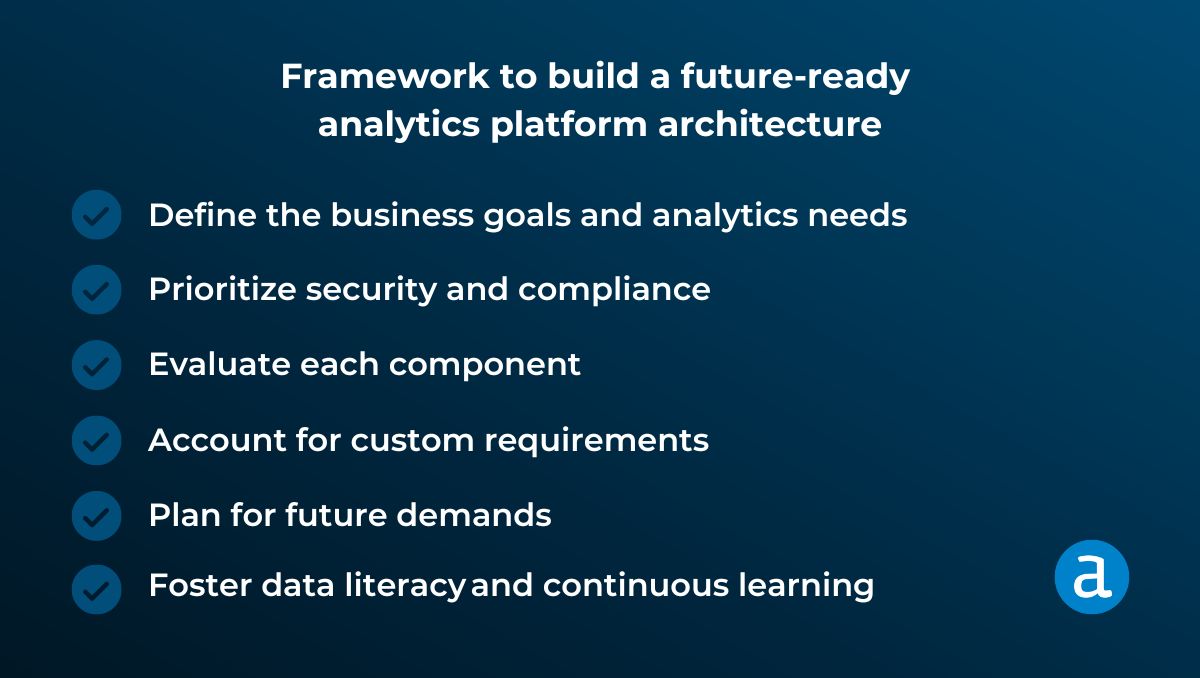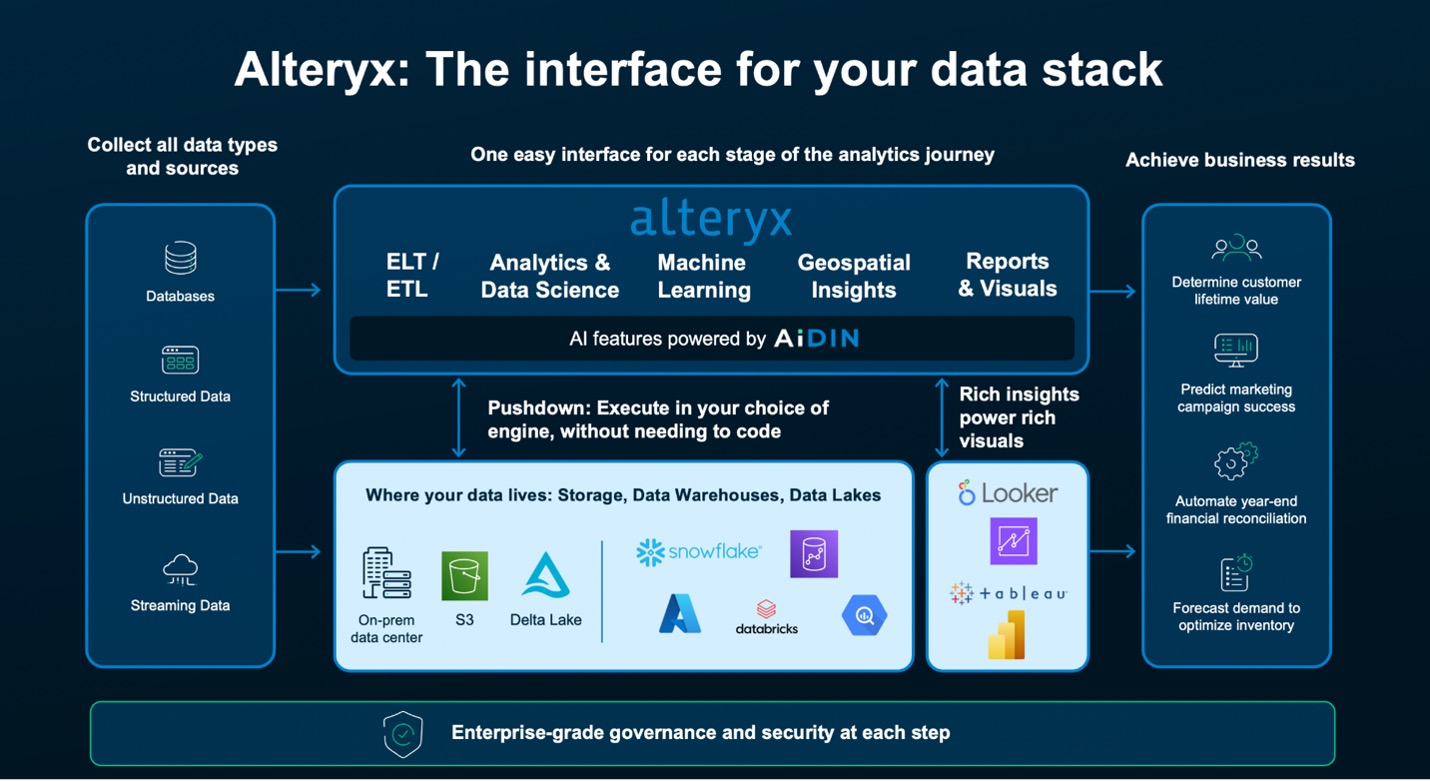What is an analytics architecture?
An analytics architecture refers to the infrastructure and systems that enable organizations to effectively collect, manage, process, and analyze data to derive insights. The goal of a data and analytics architecture is to provide a scalable foundation for organizations to leverage their data assets effectively.
Every company’s analytics architecture will look different, but the foundational elements will typically consist of the following:
- Data storage – Reliably store, organize, and manage vast amounts of data from different data sources.
- Data ingestion – Collect and import data from various sources to be prepared for analysis.
- Data processing – Transform, clean, and prepare raw data into a format ready for analysis.
- Analytics layer – The last mile of analytics architecture. Data is analyzed in the analytics layer to extract insights, patterns, and predictions.
With the advent of generative AI, the cloud, and machine learning, the requirements for building architecture are shifting; architectures must now accommodate new and different use cases. An analytics architecture is no longer data lakes and data warehouses, it’s also finding ways to store and access insights from unstructured data, store larger data sets, and process data in real-time. This is required to take analytics insights to the next level and prepare for the widespread use of AI.
Benefits of a strong analytics architecture
Having a robust architecture is crucial for organizations to deliver strategic business value. Analytics provides insights that aren’t attainable through other methods, and by supporting analytics with robust and future-proof architecture, businesses can fully leverage their data, which is integral for informed decision-making and strategic planning.
As we move into the new era of generative AI and other advanced AI technologies, having a solid bedrock of data will give companies a head start and the best possible results. And the good news is that most organizations still have the opportunity to modernize, as only 10% of companies surveyed in a recent study stated that they have what is defined as a “modern data stack.” Building or modernizing analytics infrastructure will support new demands more easily in the face of unprecedented technological innovation.
One of the most significant benefits of an updated architecture is the ability to incorporate new technologies, particularly AI. A modern approach to analytics architecture will prepare the infrastructure to handle anticipated future demands, like the increasing importance of unstructured data and the need to process and access data in real-time, unlocking use cases, and delivering value from more of an organization’s data. According to a study from IDC, 70% of organizations believe their data is underutilized. Optimizing infrastructure for AI will make it possible for organizations to extract more value from their data assets.
Best practices and considerations
When building or modernizing an analytics architecture, data accuracy and quality should be prioritized, alignment with business goals, and administrative ease of use.
Data accuracy and quality
To prioritize data accuracy and quality in an analytics architecture, define clear data quality standards. Implement proactive measures like input validation, data profiling, and automated cleaning. Establish a robust data governance framework that outlines roles, responsibilities, and change management protocols.
Alignment to business goals
To align analytics to business goals, identify stakeholders and understand the KPIs they use to measure success. Focus on the aspects of the analytics architecture that will yield the most significant impact on these goals and communicate with stakeholders about how the architecture enables insights and outcomes that they find valuable.
Administrative ease of use
One concept to consider when building an analytics architecture is “administrative ease of use.” This means simplifying the tasks associated with managing data access and monitoring in an organization and prioritizing tools and solutions that ease the burden on administrators by enhancing visibility, scalability, data lineage, and data integration with existing systems. By prioritizing administrative ease of use, the analytics architecture will simplify governance by providing better visibility and control over data, support scalability by accommodating growth, and foster a secure environment through access control and user monitoring.
Framework to build a future-ready analytics platform architecture

To build a scalable analytics platform architecture, organizations need to start with the basics and focus on their business goals, upgrading their architecture to be ready for more sophisticated analytics and AI use cases. Keeping that in mind, they should follow this roadmap to start building or upgrading their analytics architecture:
Step 1: Define the business goals and analytics needs
The foundation of a scalable architecture is a clear understanding of a company’s business goals. What key performance indicators (KPIs) will the analytics platform track? How will these insights be used to inform strategic decision-making? Identifying these crucial metrics will guide the selection of essential components within the architecture.
When defining critical components, organizations should consider the options for the foundational elements of an analytics architecture: data storage, data ingestion, data processing, data transformation, and analytics.
Step 2: Prioritize security and compliance
The architecture must support the organization’s adherence to regulations and standards. Businesses need to clearly define their data management, protection, trust, and compliance needs. This includes factors like data encryption, access control, and regulatory compliance specific to their industry. For example, if an industry has robust security standards that require data to be kept in a specific geolocation, document this and make it a requirement for the architecture design.
Step 3: Evaluate each component
Break out the architecture into independent components or modules. Each module can then be designed, tested separately, and later incorporated into the final architecture. Separate each module by the stage of data analytics, such as data storage, data ingestion, data processing, and analytics tools, and test individually.
With modular design, investing time into independent testing allows for more flexibility when new technology is developed. Modules can then be more easily switched out without needing to overhaul the entire infrastructure.
Step 4: Account for custom requirements
At this step, document any custom requirements that aren’t driven by security or business requirements. This may include skills of their team, the difficulty of hiring new team members with the skills required to maintain and update the architecture, the types of data they want to store in the architecture, and the use cases the architecture will facilitate.
For example, if an organization wants the architecture to one day support the development of AI or a custom large language model (LLM), they will need to add a requirement of supporting various data types, including structured and unstructured data.
Step 5: Plan for future demands
Consider what new demands may look like for analytics and data usage, and then document how that will shape the architecture. Prioritize adaptability, scalability, and flexibility when building the architecture.
When focusing on adaptability, build an architecture that can adapt to new requirements and technological advancements without requiring complete overhauls – ensure any potential vendors are incorporating new technologies into their solution and pay attention to their innovation plans.
To ensure scalable and flexible infrastructure, ensure that the architecture can adjust based on data volumes and analytic demands. Cloud products can be a great solution as cloud-based solutions are inherently scalable and flexible while offering automatic updates.
Step 6: Foster data literacy and continuous learning
Having a modern analytics architecture is only as good as how often it is used, so building a foundation of data-literate employees across the business is a smart way to ensure the architecture stands the test of time. This also includes educating and communicating with business stakeholders about how the architecture is built and what the benefits and capabilities are. Create programs and training to ensure buy-in and effective use across the organization. Monitor industry trends and advancements within AI and analytics for a competitive advantage.

Get started with Alteryx
Use your data to it’s full potential with Alteryx. With a user-friendly interface, seamlessly integrate data from AWS, Databricks, Snowflake, Azure, and more.
Explore how Alteryx integrations can empower your organization:
- Unified platform: Alteryx offers a unified platform for managing data and analytics in the cloud. Alteryx offers tools for building data pipelines, geospatial analytics, predictive models, and robust controls for data governance.
- Flexible deployment options: For greater control of how data is processed, Alteryx offers private data processing and storage.
- Pushdown execution: Analyze data directly in its source (data warehouse, data lake, or native processing engine) for faster processing, lower costs, and wider accessibility.